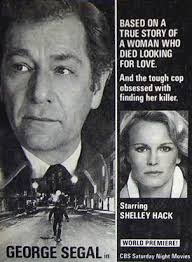
TRACKDOWN: THE FINDING OF THE GOODBAR KILLER
US, 1983, 86 minutes, Colour.
George Segal, Shelley Hack.
Directed by Bill Persky.
Trackdown: the Finding of the Goodbar killer is a telemovie of the early 80s. It focuses on police work and detection. However, as the prologue suggests, it is a follow on to Richard Brook's celebrated and controversial film of the late 70s, looking for Mr Goodbar. In that film, Diane Keaton portrayed a teacher of deaf children who had repressed her sexuality and, living on her own, cruised single bars at night, ultimately encountering a psychotic man who killed her. This film constantly refers to the earlier film. (Tom Berenger, in an early role played the killer.) This is a more conventional film with George Segal playing the detective. Their are complications at home with his wife wanting to leave him and his daughter wanting to go to College. He encounters another teacher of the deaf (Shelley Hack), finds a suspect but decides he is not the killer. Acting shrewdly, he tracks down the homosexual friend of the killer and eventually there is an elaborate set-up to trap and arrest the killer. The film is interesting in its portrayal of detective work.
1. Interesting telemovie? Murder thriller? Portrait of police work and detection? Domestic complications?
2. New York settings, homes, the clubs, the streets? The seamier world of New York? The musical score? The credits and Laura Branigan's Gloria setting the tone for the singles bars?
3. The title, the focus? Audience knowledge of the original film? This film being able to stand on its own?
4. The situation: Mary Alice Nolan and her background, her teaching, her family? Her going to the singles bars, picking up men? Returning to her flat? Her death? The squalid aspects of her life and death? The killer, his angers, homosexuality, relationships, telling the truth to his friend who did not believe him? His leaving for Florida, hoping to escape detection, reading the papers?
5. John Grafton and his work for the New York police, dedicated? George Segal's style? His relationship with his superiors and their help? His associate? The team? His skill in making connections, gathering evidence? Taping the phone call? Suspects, interrogations? Footwork on the streets? His visit to the school, the antagonistic teacher? The later romantic entanglement? His following up the leads with the Popeye drawing? The artists, the recognition of those drawn? His interviewing Cahill? The phone call identity? The set-up of the phone call in Indiana? The raid and the arrest?
6. The background of his relationship with his wife, dedicated to his work, home sequences? The wife wanting to leave? Love for his daughter, seeing her as a child, her wanting to go to Syracuse for study? The portrait of the wife - long suffering, yet loving her husband? Coming home and his jealousy? Her inviting him to stay the night? Love for the daughter, her visits to the precinct? The resolution about her studies? The domestic background to the police work?
7. The suspect, the interrogation? His not being the killer? The teacher and her antagonistic attitude towards the police, the futility of the questions, her giving answers?
8. The homosexual background, the killer and his relationships? His companion not believing him? Attached to him? The phone call, The papers? His dilemma? His being identified? Getting his lawyer? Telling the truth ? and the ordeal of the phone call, leading the killer on, getting him to confess?
9. The portrait? of the killer, any insight into what motivated him? His madness? relationships? His sister ? and the arrest?
10. A portrait of police work, without the guns and the sensationalism of the popular police series and movies of the 70s and 80s?